Delicious vegetarian lasagna with zucchini and spinach. It’s cheesy, packed with flavor and vegetables. Everyone loves it, even the meat-eaters! Crispy zucchini, creamy spinach, flavorful meatless tomato sauce, and delicate béchamel sauce, plus a lot of grated parmesan cheese on top – it’s really pure comfort food! Make sure to try it, you‘ll be delighted!
Try also my other vegetarian lasagna recipe – white lasagna with pumpkin and mushrooms!
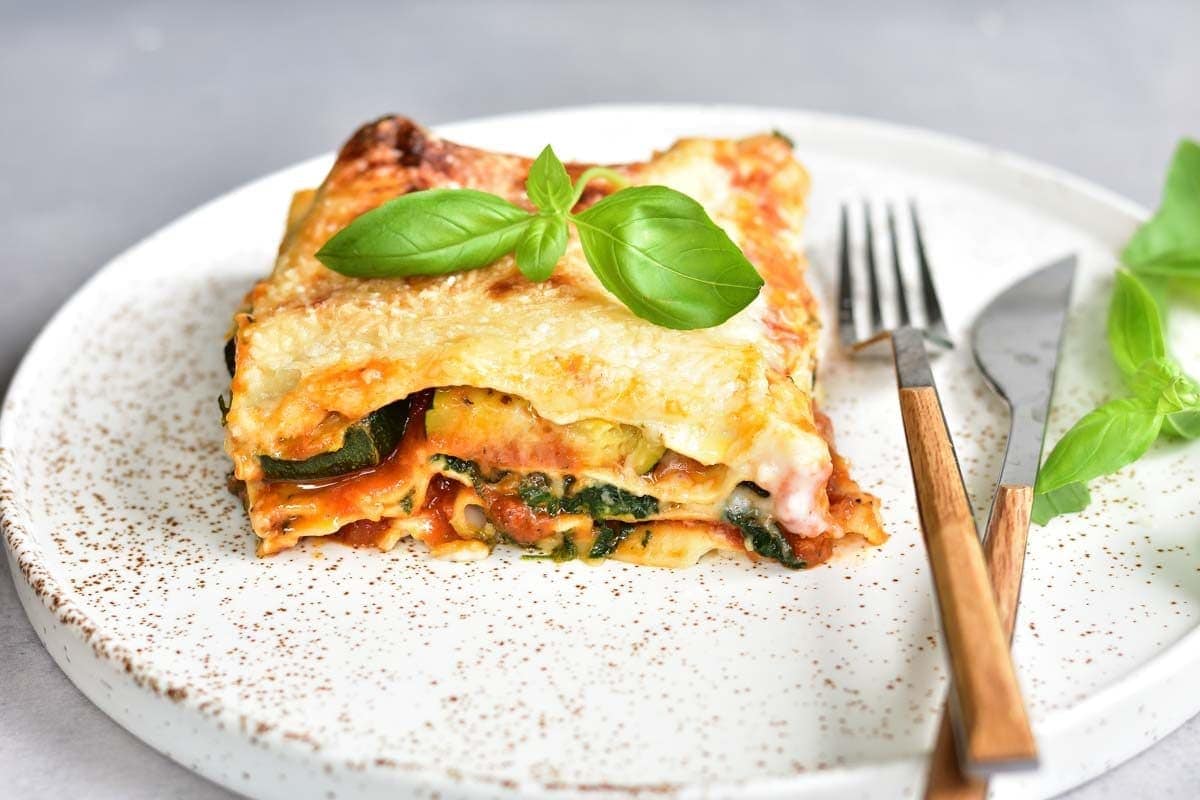
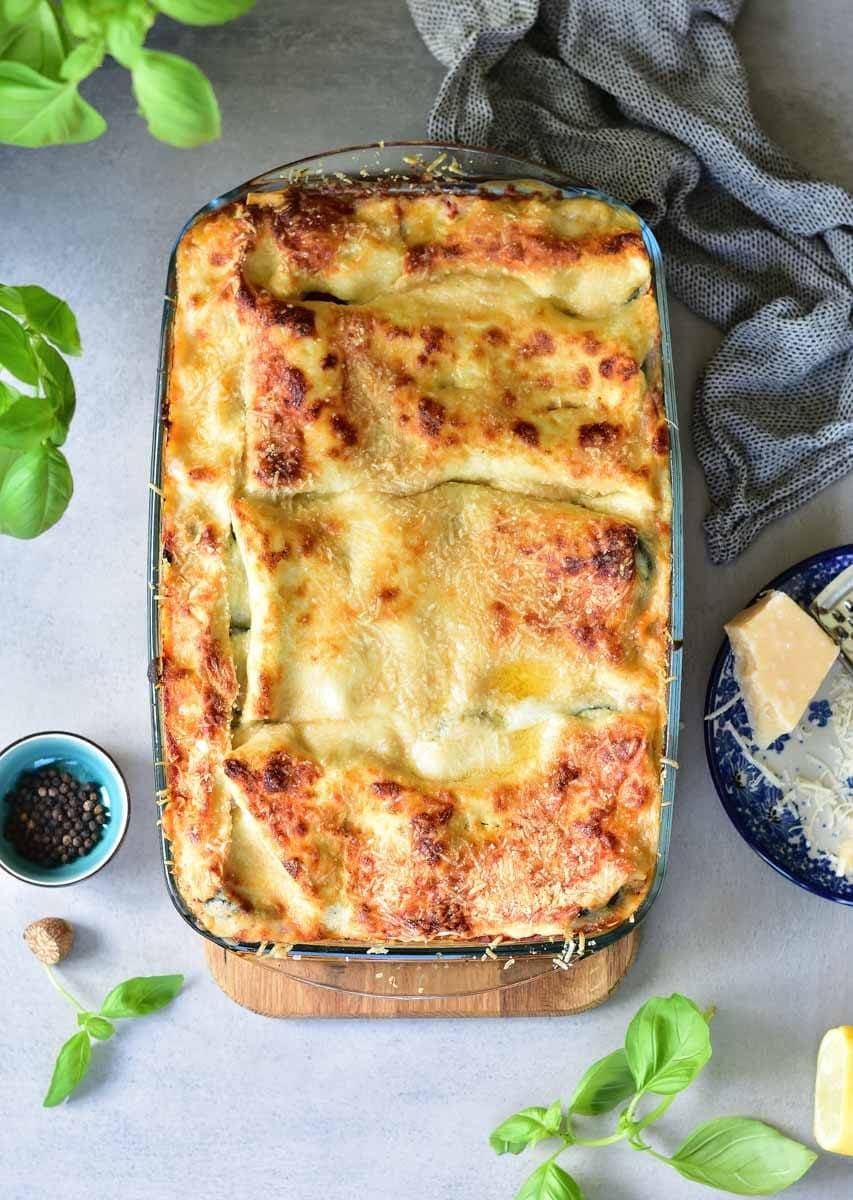
Ingredients
This lasagna is made with meatless tomato sauce, bechamel sauce, roasted zucchini, sauteed spinach, grated Parmesan cheese, and lasagna noodles.
A note about the cheese: if you are on a strict vegetarian diet, use rennin-free Parmesan cheese. Alternatively, you can use mozzarella cheese (about 7 oz / 200g).
If you’re short on time, you can make my marinara sauce which is ready in 25 minutes.
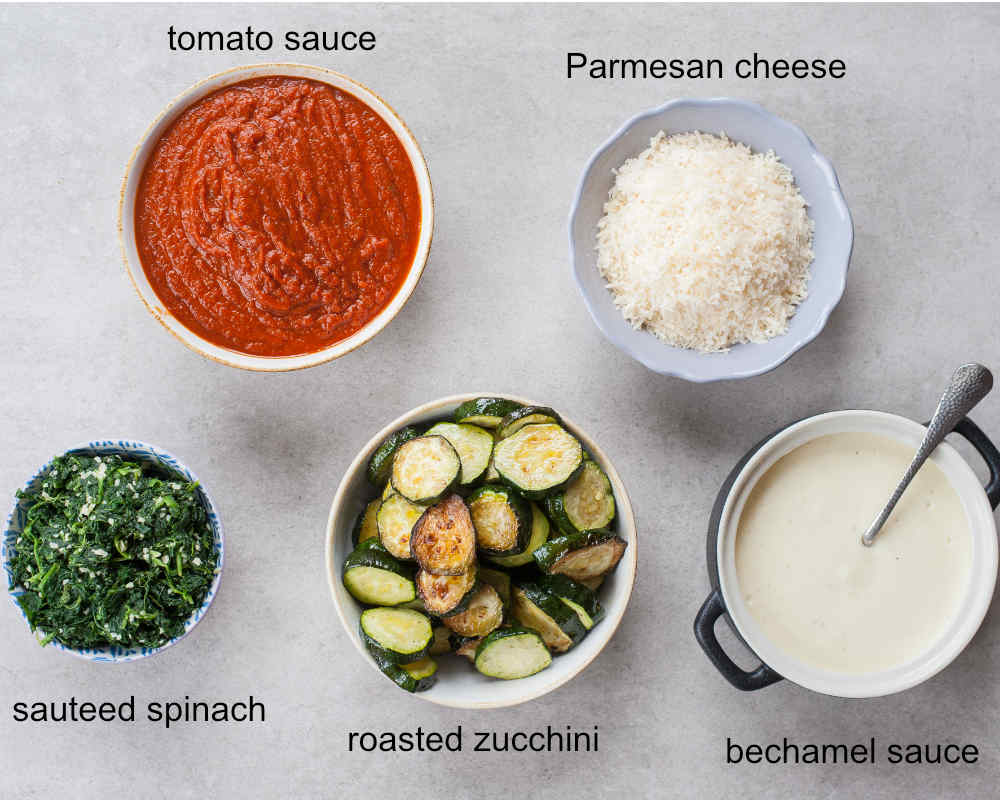
Do lasagna noodles have to be cooked first?
Short answer: No, with this recipe you don’t have to cook lasagna noodles. The general rule is to use no-boil dry lasagna noodles (they are widely available) and use sauce that meets 2 criteria: is runny enough + there is a generous amount of sauce that thoroughly covers the pasta. This recipe is created this way and your dry noodles will be cooked through 100%.
Longer explanation / What kind of noodles can you use:
- Dry lasagna sheets: I never boil my lasagna noodles. Using dry lasagna sheets is quicker, more convenient and the pasta is delicious this way. It soaks up the delicious sauce and not plain water. The only problem that you can encounter is when your baking dish has not square but round edges or is of a different size than your lasagna noodles. I usually just break the noodles to fit them into my baking dish. I’ve recently read about soaking the noodles and now it’s my go-to method. I soak the noodles in water for 5-10 minutes or until just slightly pliable. (take them immediately out of the water or they will be too soft after baking the lasagna). Then I brake them or cut them so that they fit perfectly in my baking dish. This is optional!
- Fresh lasagna noodles can also be used. You can even make your homemade pasta.
- You can also pre-boil lasagna sheets if you wish. Just cook them for 1-2 minutes, then take out of the pot with a slotted spoon and place on a chopping board apart (otherwise they can stick to each other).
Zucchini spinach lasagna – step by step instructions
STEP 1: Start with making vegetarian tomato sauce. Detailed instructions and photos can be found in a separate post: meatless tomato sauce.
Finely chop 1 large onion and 1 celery stalk, grate 2 small carrots on the small holes of a box grater. Finely chop 4 cloves of garlic. In a large pot, warm 3 Tbsp of oil over medium heat. Once hot, add the chopped onion, celery, and carrots, 1/2 ts of dried oregano and 1 ts of dried basil (if you’re using fresh basil leaves, you can skip dried basil). Cook for about 10 minutes, stirring frequently. Add the chopped garlic, cook for a minute. Add 1/4 cup of dry red wine, cook, stirring, for a few minutes, until almost completely evaporated. Add 1 (24 fl oz/700ml) jar of tomato passata, 1 (14 oz/400g) can of crushed tomatoes and 1 cup of vegetable broth (broth is optional! only if you have time to cook the sauce about 40 minutes longer, so that the excess liquid can evaporate, the sauce with the broth will be tastier, but you can easily skip it if you don’t have time). Cook for about 30 minutes (partially covered) until the sauce thickens, stirring from time to time (especially at the end). Take the pot off the heat. Season the sauce with 1 ts of balsamic vinegar, 1 ts of sugar and salt, and pepper to taste. Add a small handful of fresh basil leaves (if using) and puree the sauce with a hand/immersion blender until smooth.
You will have a little tomato sauce left (about 1 cup). You can cook a quick spaghetti for 2 people – cook about 7 oz / 200 g ground meat (or pan-fry some vegetables like zucchini or eggplants) in a frying pan until nicely brown but not dry, mix with tomato sauce and serve with al dente-cooked spaghetti.
STEP 2: Roast the zucchini: Preheat the oven to 220 °C / 450 °F / Gas 8, no fan. Cut 2 lbs / 850g zucchini (3 medium) into thick, ½ inch / 1 cm slices. Spread in a single layer on a baking sheet, brush on both sides with 2 Tbsp of olive oil, season with salt and pepper to taste. Roast for about 15 minutes. Roasting the zucchini drives off excess moisture (the lasagna would be too runny) + browned zucchini provides lots of flavor).
STEP 3: Prepare the spinach layer. Thaw 11 oz / 300g spinach and squeeze out the excess water. Add 1 Tbsp of butter to a medium skillet, once it’s melted and bubbling, add 3 finely chopped cloves garlic, cook for approx. 30 seconds, then add the spinach and 1/3 ts of ground nutmeg. Cook for about 2 minutes, season with salt and pepper to taste (when using fresh spinach leaves, cook them only until they wilt).
STEP 4: Grate 1 1/2 cups / 4.2 oz / 120g Parmesan cheese.
STEP 5: Make the bechamel sauce (detailed instructions, preparation photos, and additional information about the bechamel sauce can be found in a separate post: foolproof bechamel sauce). In a medium pot, melt 3 Tbsp / 1.4 oz / 40g of butter over medium heat, once it’s bubbling, add 5 Tbsp / 1.4 oz / 40g of flour, whisk until combined. Gradually add 2 cups of milk (480-500ml, a little at a time, about ⅓ cup / 100 ml). Stir thoroughly after each addition, making sure that no lumps form. The next portion can be added when the previous one is well combined. Remove the pot from heat, season the sauce with 1 Tbsp of lemon juice, 1/4 ts of nutmeg and salt, and pepper to taste.
STEP 6: Assemble the lasagna – all the steps are pictured below.
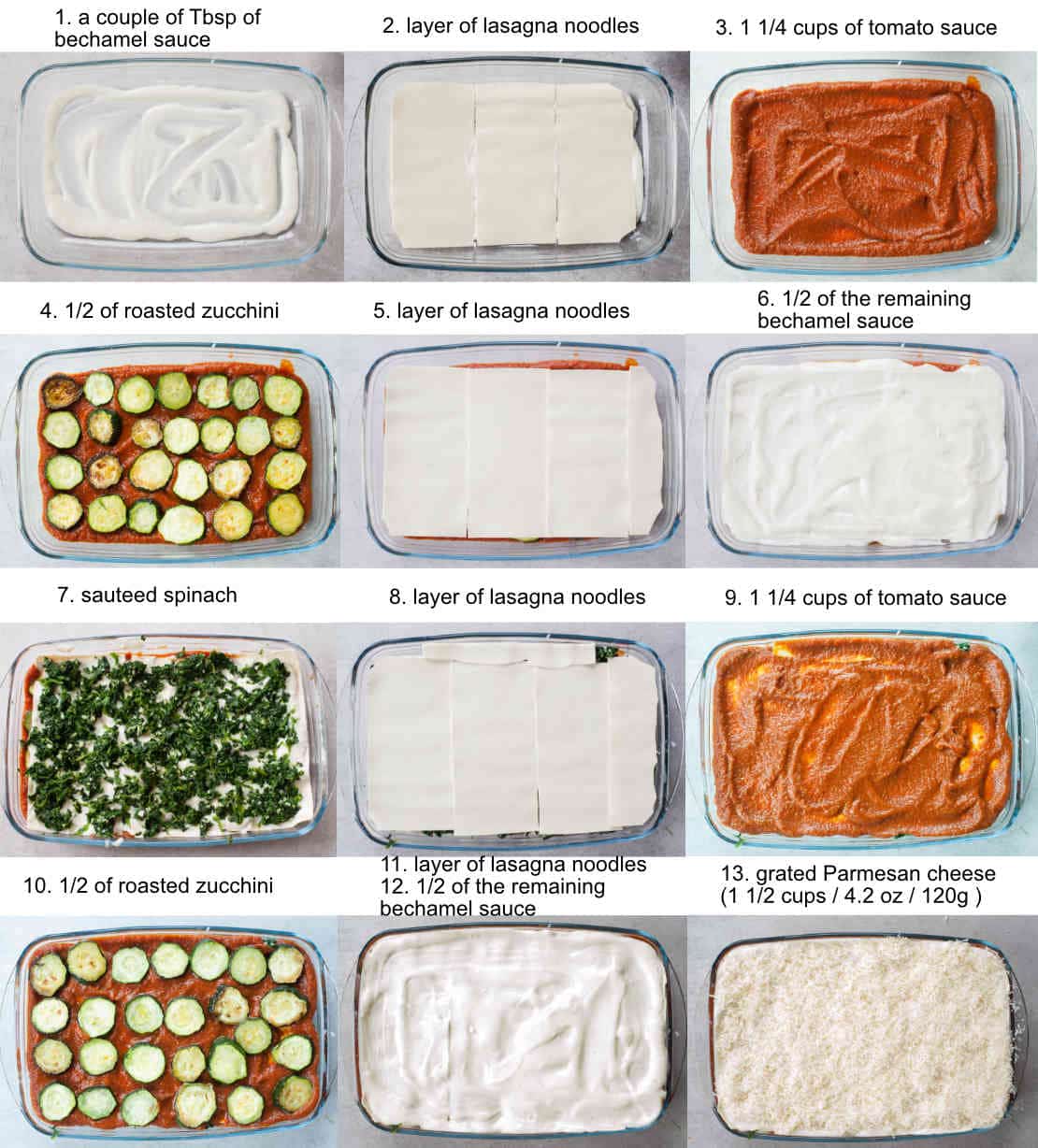
How to double the recipe
As with any lasagne, the preparation is a bit time-consuming, so I really recommend doubling the recipe – I often bake it in a very large 32×38 cm / 13×15 inch baking dish. To see the doubled ingredients, move the slider in the recipe card by changing the servings number from 4 to 8. Please note, that only the amounts at the beginning of the line will change, and NOT the additional measurements that I provide at the end of the line of each ingredient. For example: 3 medium zucchini will change to 6 medium zucchini, but the note “about 2 lbs / 850g ” at the end of the line won’t change. I have a separate post for meatless tomato sauce and the recipe there is already doubled.
Storing and freezing instructions
Any lasagna is perfect for storing and freezing:
Store it tightly covered for up to 3 days in the fridge.
How to freeze: I recommend dividing it into servings first (although it’s not necessary, just easier to thaw). Then you can defrost and warm up each serving directly in the oven heated to 320°F / 160°C.
Did you make this recipe? RATE THE RECIPE or tell me in the COMMENTS how you liked it! You can also add a photo of your dish. It would make me very happy and will help other readers. Thank you!!
Vegetarian lasagna with zucchini and spinach
Ingredients
14 lasagna sheets
tomato sauce:
- 1 large onion
- 2 small carrots
- 1 stalk celery or 1/2 teaspoon fennel seeds
- ½ teaspoon dried oregano
- 1 heaping teaspoon dried basil can be omitted when using fresh basil leaves
- 3 tablespoons frying oil
- 4 cloves garlic
- 1/4 cup red wine dry/semi-dry, can be omitted or sub for broth
- 1 jar tomato puree/passata 24 fl oz / 680 ml
- 1 can crushed tomatoes 14 oz / 400g
- 1 cup vegetable broth optional, only if you have more time to cook the sauce!
- 1 teaspoon balsamic vinegar
- 1 teaspoon brown sugar
- a small handful fresh basil leaves about 12 large leaves, or you can use only dried basil
spinach:
- 11 oz frozen spinach thawed, 300g
- 1 tablespoon butter
- 3 cloves garlic finely chopped
- 1/4 teaspoon nutmeg
- salt and pepper to taste
zucchini:
- 3 medium zucchini about 2 lbs / 850g
- 2 tablespoons olive oil
- salt and pepper to taste
bechamel sauce:
- 3 tablespoons butter 1.4 oz/40g
- 5 tablespoons flour 1.4 oz/40g
- 2 cups milk 480-500 ml
- 1 tablespoon lemon juice
- ¼ teaspoon nutmeg
- salt and pepper to taste
additionally:
- 2 ½ cups grated Parmesan cheese 4.2 oz / 120g
Would you like to save this?
Instructions
tomato sauce:
- Finely chop the onion and celery stalk, grate the carrot on the small holes of a box grater. Finely chop the garlic.
- In a large pot, warm the oil over medium heat. Once hot, add the chopped onion, celery and carrots and dried spices (if you’re using fresh basil leaves, you can skip dried basil). Cook for about 10 minutes, stirring frequently.
- Add the chopped garlic, cook for a minute.
- Add the wine, cook, stirring, for a few minutes, until almost completely evaporated.
- Add the tomato passata, crushed canned tomatoes and broth (broth is optional! only if you have time to cook the sauce about 40 minutes longer, so that the excess liquid can evaporate, the sauce with the broth will be tastier, but you can easily skip it if you don’t have time). Cook for about 30 minutes (partially covered) until the sauce thickens, stirring from time to time (especially at the end). Take the pot off the heat.
- Season the sauce with balsamic vinegar, sugar and salt, and pepper to taste.
- Add basil leaves (if using) and puree the sauce with a hand/immersion blender until smooth.
- While the sauce is cooking, prepare the spinach and zucchini.
- Preheat the oven to 220 °C / 450 °F / Gas 8, no fan (if you have a convection oven reduce the temperature by about 20° of follow the manufacturer's instructions).
spinach:
- Thaw the spinach and squeeze out the excess water.
- Add the butter to a medium skillet, once it’s melted and bubbling, add the garlic, cook for approx. 30 seconds, then add the spinach and nutmeg. Cook for about 2 minutes, season with salt and pepper to taste (when using fresh spinach leaves, cook them only until they wilt). Roughly chop the spinach (this is important).
zucchini:
- Cut the zucchini into thick, about 1 cm / ½ inch slices.
- Spread the zucchini in a single layer on a baking sheet, brush on both sides with olive oil, season with salt and pepper to taste.
- Roast for about 15 minutes until slightly tender (doesn't have to be completely cooked through) and lightly browned.
- While the zucchini is baking, prepare the béchamel sauce.
- After removing the zucchini from the oven, reduce the oven temperature to 190 °C / 375 °F / Gas Mark 5, no fan.
bechamel sauce:
- In a medium pot, melt the butter over medium heat, once it’s bubbling, add the flour, whisk until combined.
- Gradually add the milk (a little at a time, about ⅓ cup / 100 ml), stir thoroughly after each addition, making sure that no lumps form. The next portion can be added when the previous one is well combined.
- Remove the pot from heat, season the sauce with lemon juice, nutmeg and salt and pepper to taste.
assembling the lasagna:
- Prepare a 31×21 cm / 12×8 inch (or similar) baking dish.
- Spread a couple of tablespoons of the bechamel sauce at the bottom of the dish.
- Place the first layer of uncooked lasagna noodles on top (I prefer to soak dry lasagna noodles in water for 5 minutes before layering the lasagna).
- Spread 1 and ¼ cups of tomato sauce.
- Place ½ zucchini slices on top, then 3.5 lasagne noodles.
- Spoon 1/2 of the remaining béchamel sauce on top.
- Spread the spinach in an even layer, cover with 3.5 lasagne noodles and spoon 1 and ¼ cups of tomato sauce.
- Arrange the remaining ½ zucchini slices, then put another layer of lasagne noodles, and spoon the remaining bechamel sauce on top.
- Sprinkle the parmesan cheese on top.
- Bake for about 35 minutes, until golden brown on top and bubbling.
- Take the lasagna out of the oven and wait about 15 minutes before cutting the lasagne into portions (it needs time to set, otherwise, it will be too liquid).
- Serve warm and enjoy!
Notes
- 1 cup is 240-250 ml
- You will have a little tomato sauce left (about 1 cup). You can cook a quick spaghetti for 2 people – cook about 7 oz / 200 g ground meat (or pan-fry some vegetables like zucchini or eggplants) in a frying pan until nicely brown but not dry, mix with tomato sauce and serve with al dente-cooked spaghetti.
- Calories count = 1/5 of the recipe. This is only an estimate.
- If you are on a strict vegetarian diet, make sure to use a vegetarian Parmesan cheese/rennet-free Parmesan or substitute for 7 oz / 200g mozzarella cheese.
- What kind of lasagna noodles can you use:
- Dry lasagna sheets: I never boil my lasagna noodles. Using dry lasagna sheets is quicker, more convenient and the pasta is delicious this way. It soaks up the delicious sauce and not plain water. The only problem that you can encounter is when your baking dish has not square but round edges or is of a different size than your lasagna noodles. I usually just break the noodles to fit them into my baking dish. I’ve recently read about soaking the noodles and now it’s my go-to method. I soak the noodles in water for 5-10 minutes or until just slightly pliable. (take them immediately out of the water or they will be too soft after baking the lasagna). Then I brake them or cut them so that they fit perfectly in my baking dish. This is optional!
- Fresh lasagna noodles can also be used. You can even make your homemade pasta.
- You can also pre-boil lasagna sheets if you wish. Just cook them for 1-2 minutes, then take out of the pot with a slotted spoon and place on a chopping board apart (otherwise they can stick to each other).
- How to double the recipe: As with any lasagne, the preparation is a bit time-consuming, so I really recommend doubling the recipe – I often bake it in a very large 32×38 cm / 13×15 inch baking dish. To see the doubled ingredients, move the slider in the recipe card by changing the servings number from 4 to 8. Please note, that only the amounts at the beginning of the line will change, and NOT the additional measurements that I provide at the end of the line of each ingredient. For example: 3 medium zucchini will change to 6 medium zucchini, but by note “about 2 lbs / 850g ” at the end of the line won’t change. I have a separate post for meatless tomato sauce and the recipe there is already doubled.
- Storing the lasagna: Store it tightly covered for up to 3 days in the fridge.
- How to freeze: I recommend dividing it into servings first (although it’s not necessary, just easier to defrost). Then you can defrost and warm up each serving directly in the oven heated to 320°F / 160°C.

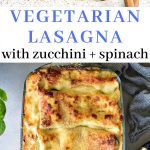
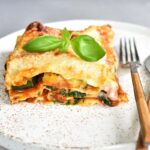

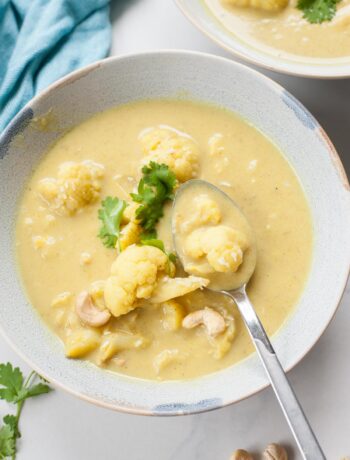
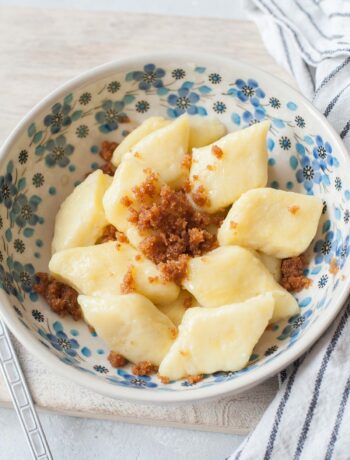
2 Comments
Anna
6 December 2019 at 20:41There’s no doubt it will be delicious❤️ I am gonna do this next week
Aleksandra
6 December 2019 at 20:46Thank you! Please let me know how you got on! 🙂